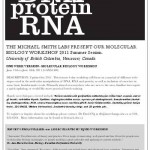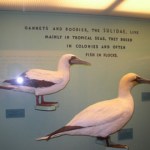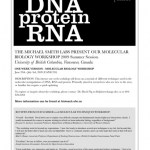I just noticed that there's a workshop being offered from June 13th to June 18th, 2011, in Vancouver, Canada, that provides technical and hands-on training for "scientists and non-scientists interested in human cloning." This course has a price tag of $1400 (does not include transportation, room and board) and apparently provides the following:
"This professional course (which can accept only 12 clients) will guide participants through the various methodologies involved in the production of a human clone. This includes extensive lectures on the various techniques as well as a significant…
Nature, as in parts, bits, molecular and stuff
@dnghub Twitter Feed
Yesterday I noticed that the web was a buzzing over two things in particular. One being the news of Craig Venter's work on a proof of principle example of producing a synthetic organism, and the other being the unveiling of London's 2012 Olympic mascots.
Venter's work certainly is an achievement - particularly in the technical realm. The accomplishment of synthesizing a piece of DNA that big (nevermind that the code was derived from digital infomation) and then putting it inside a DNA-less cell, in manner where all appears well is actually quite the kudos. Add to that…
So, today 22 Grade 1's and 2's came to my lab.
So what to do? What to do? That's a lot of kids in a full on laboratory settng. I've written about this activity before, but here goes again.
Thankfully, this is where ScienceBlogs rocks, since I had happened upon an awesome post by Janet over at Adventures in Science and Ethics that was all about the simple act of "just adding water" to see what happens.
The only difference here, of course, is that we got to do it at a real lab, so it was wonderful to see the kids get a real hearty dose of science culture as it were.
As well, just to make it…
I actually mentioned this video earlier, but you know, I don't think I did the pitch justice.
So...
Basically a TEDx talk by Jennifer Gardy, who outlines just how freaking fast that H1N1 information has been obtained. And all because of the open source and open access nature of the research work.
For example, when SARS hit the fan in 2003, it took 19 days for its genome to be sequenced. This year with the H1N1 swine flu, in that same 19 day timeframe, over 100 viral genomes had been sequenced, analysis had been done (and published) that worked out the origin and timeframe of the virus, and…
Science Scout twitter feed
With Ben providing a nice substance abuse prelude, it seems like a good enough time to also explore other things related to death. Such as lethal doses - i.e. for things we scientists particularly indulge in (like coffee and alcohol and, yes - the free cookies at Departmental seminars). We'll start by looking at the fatality of coffee for this post, and here, for the scientist, the first place to look a little deeper into this is the vaulted MSDS (or Material Safety Data Sheet).
For those not initiated in this lingo, MSDS are those documents that provide risk…
Science Scout twitter feed
Unicorns are great. Seriously. And here I'm going to sort of think out loud and think of them in a conventional biology sort of way. You know - have a little fun evolution wise.
In many respects (except for the magical powers bit) I don't think this is necessarily too hard to do. i.e. you have something that looks like a horse, but hey what's this - there's also a horn there.
I guess the question I'm pondering is whether a unicorn could occur from a realistic evolutionary biology point of view - you know, given the right circumstances and the right…
Science Scout twitter feed
Photo of a nice set of boobies we saw at the Natural History Museum from the SCQ
So the question, of course, is "what exactly is up with birds and breasts?" And I'm not talking about white meat versus dark meat preferences.
Instead, there is this uncomfortable coincidence between bird names and colloquialisms associated with women's breasts. It's almost as if you can do this mental exercise of running off a list of slang words, and then seeing if there is a connection to avian nomenclature.
For example, you have the implied: such as hooters, where even…
Science scout twitter feed
I'm doing a bit of research for book chapter, and one of the things I was looking into, was how much exactly would it take for a layman to set up a functional molecular biology lab. With respect to this query, there are a few things to keep in mind:
1. Most molecular biology research is driven by the use of plastic ware, and various biological reagents. These are the sorts of things that need to bought fresh or brand new. Fortunately, most of it is also quite affordable from a layman point of view, and as previously demonstrated, you can easily purchase this…
Just a quick note.
I would appreciate any efforts and good words you have to pass on to your colleagues about our upcoming molecular techniques workshop (see below). As well, I've included a pdf of the workshops poster, perfect for posting up on your friendly neighborhood bulletin board. Also note that the revenues generated by this workshop go directly into our outreach programs at bioteach.ubc.ca so this help would be greatly appreciated.
Download
poster
And the details....
*THE MICHAEL SMITH LABS AND ADVANCED MOLECULAR BIOLOGY LAB PRESENTS OUR MOLECULAR BIOLOGY *
*WORKSHOPS 2009…
Science scout twitter feed
The reason why there were two ways of saying the element aluminum/aluminium has always been one of the those things that made me go "hmmm" But by the same token, it's also always been one of those things that never stuck around in my consciousness long enough for me to look it up.
Well, lucky for all us, Michael Quinion over at World Wide Words does an awesome job of going into the lexicon of these words, paying particular attention to why two forms exist - specifically, why the Brits say "Alumininium" and why Americans say "Aluminum."
It's actually quite…
Last week, my daughter had her seventh birthday party, and it makes my heart swell to tell you that she wanted to have it at my lab this year.
So what to do? What to do? With 15 or so six/seven year olds in a full on laboratory settng. Well, thankfully, this is where ScienceBlogs rocks, since I had happened upon an awesome post by Janet over at Adventures in Science and Ethics that was all about the simple act of "just adding water" to see what happens.
The only difference here, of course, is that we got to do it at a real lab, so it was wonderful to see the kids get a real hearty dose of…
This is silly is so many ways. Hat tip to the filter.
Occasionally, I talk about this when I'm giving a talk on science literacy, and most often, I'll present the following statement asking if it's true or false:
There is a human disease characterized by uncontrollably messy hair. It is called the "uncombable hair syndrome."
Anyway, it's true and the disorder is also known as Pili trianguli et canaliculi
Basically, a genetic syndrome affecting the structure of one of the proteins in the hair follicle. Results in literally uncombable hair (hence the name).
An abstract from Pediatr Dermatol. 2007 Jul-Aug;24(4):436-8.
A 4-year-old boy was noted…
So it would seem my last post on pinatas needs to be corrected on two fronts. Firstly, my piece at McSweeney's and its marriage of science and pinatas is not such a unique concept, and secondly, after doing a bit more homework, it's clear that the best blogging category to unite these two terms is "Life Science." (and not "Humanities and Social Sciences" as previously suggested.
Why is this? Well, the term "pinata" (apologies for not including the little squiggle over the "n" - everytime I try, it comes out garbled) does crop up when you do literature searches. In fact, whilst the hits are…
This post was written by guest contributor Cyrus Mody.*
There's a new study reported in Nature Nanotechnology entitled "Carbon nanotubes introduced into the abdominal cavity of mice show asbestos-like pathogenicity in a pilot study." Or, as the title seems to have been understood by reporters at the New York Times and elsewhere, "Blah NANO blah blah blah ASBESTOS blah PATHOGEN blah blah."
The gist of the original Nature Nano study is this: (1) we know asbestos fibers, once heralded as a godsend, can cause mesothelioma, a cancer of the lining of the lungs. (2) We know this has something to…
The opener for my lecture last week. Note that I got the biggest laughs with Grimace (Grimace is always good for a laugh), and with the Olympic mascots (a Vancouver thing). Know any others? (click on the movie).
(Click on the movie to move through slides)
(I didn't actually see this sign, which I got via Shelley, but I put it up because my talk later today will actually break rule number 3.)
Well, I've been in China for the better part of three days now, having spent a few hours in Shanghai, and the remainder of my time in Harbin (North China). It's been lovely so far, and my hosts are pretty much all kinds of awesome.
The visit has been interesting for a number of reasons. Firstly, the opportunity to go to Shanghai for a few hours, and to try and get a feel for the place. Basically, Shanghai struck me like any other major, high rolling,…
Specific details are here, but basically, my facility is hosting two workshops for the scientific community (around the latter half of February 2008). One is a 5 day session that focuses on a myriad of molecular techniques, and incorporates both a practical hands-on portion, as well as the all important biochemical (as in what the hell is going on?) angle. Not to toot our own horns, but we've garnered consistently excellent reviews, and I would say that if you're the practicing scientist (and on occasion engineer, statistician, computer scientist, lawyer) who wants a course to get up to…
So, previously, I pointed out some of the difficulties involved in getting reagents and other scientific things to a place like Nigeria. Anyway, I thought a post like this might therefore be useful for the odd reader out there who also does this sort of thing.
Because the norm is traveling by bringing stuff along as "carry on," here's a run down of what I know. Please add more in the comments section if you have a trick or two yourself.
1. DNA constructs: Basically, the easiest thing to transport. Should easily survive any trip you plan to make with it. Of course, spiking with EDTA will…
Today sees the reprinting of a classic textbook piece at the Science Creative Quarterly. It's actually a rebuttal written by a friend to an earlier piece, but basically does an awesome job discussing the various characteristics of fat (particularly as it relates to the hot dog). Here's how the rebuttal begins:
"Although your scientific curiosity is to be applauded, your experimental methodology seems exceedingly limited, and lacks many important details. Your report describes only a single experiment, with no repetition or statistical analysis, and no meaningful description of the nature…







